#This is a long long article.
Text
B., a senior officer who used Lavender, echoed to +972 and Local Call that in the current war, officers were not required to independently review the AI system’s assessments, in order to save time and enable the mass production of human targets without hindrances.
“Everything was statistical, everything was neat — it was very dry,” B. said. He noted that this lack of supervision was permitted despite internal checks showing that Lavender’s calculations were considered accurate only 90 percent of the time; in other words, it was known in advance that 10 percent of the human targets slated for assassination were not members of the Hamas military wing at all.
For example, sources explained that the Lavender machine sometimes mistakenly flagged individuals who had communication patterns similar to known Hamas or PIJ operatives — including police and civil defense workers, militants’ relatives, residents who happened to have a name and nickname identical to that of an operative, and Gazans who used a device that once belonged to a Hamas operative.
“How close does a person have to be to Hamas to be [considered by an AI machine to be] affiliated with the organization?” said one source critical of Lavender’s inaccuracy. “It’s a vague boundary. Is a person who doesn’t receive a salary from Hamas, but helps them with all sorts of things, a Hamas operative? Is someone who was in Hamas in the past, but is no longer there today, a Hamas operative? Each of these features — characteristics that a machine would flag as suspicious — is inaccurate.”
Similar problems exist with the ability of target machines to assess the phone used by an individual marked for assassination. “In war, Palestinians change phones all the time,” said the source. “People lose contact with their families, give their phone to a friend or a wife, maybe lose it. There is no way to rely 100 percent on the automatic mechanism that determines which [phone] number belongs to whom.”
According to the sources, the army knew that the minimal human supervision in place would not discover these faults. “There was no ‘zero-error’ policy. Mistakes were treated statistically,” said a source who used Lavender. “Because of the scope and magnitude, the protocol was that even if you don’t know for sure that the machine is right, you know that statistically it’s fine. So you go for it.”
“It has proven itself,” said B., the senior source. “There’s something about the statistical approach that sets you to a certain norm and standard. There has been an illogical amount of [bombings] in this operation. This is unparalleled, in my memory. And I have much more trust in a statistical mechanism than a soldier who lost a friend two days ago. Everyone there, including me, lost people on October 7. The machine did it coldly. And that made it easier.”
Another intelligence source, who defended the reliance on the Lavender-generated kill lists of Palestinian suspects, argued that it was worth investing an intelligence officer’s time only to verify the information if the target was a senior commander in Hamas. “But when it comes to a junior militant, you don’t want to invest manpower and time in it,” he said. “In war, there is no time to incriminate every target. So you’re willing to take the margin of error of using artificial intelligence, risking collateral damage and civilians dying, and risking attacking by mistake, and to live with it.”
B. said that the reason for this automation was a constant push to generate more targets for assassination. “In a day without targets [whose feature rating was sufficient to authorize a strike], we attacked at a lower threshold. We were constantly being pressured: ‘Bring us more targets.’ They really shouted at us. We finished [killing] our targets very quickly.”
He explained that when lowering the rating threshold of Lavender, it would mark more people as targets for strikes. “At its peak, the system managed to generate 37,000 people as potential human targets,” said B. “But the numbers changed all the time, because it depends on where you set the bar of what a Hamas operative is. There were times when a Hamas operative was defined more broadly, and then the machine started bringing us all kinds of civil defense personnel, police officers, on whom it would be a shame to waste bombs. They help the Hamas government, but they don’t really endanger soldiers.”
19 notes
·
View notes
Text
the fact that shakespeare was a playwright is sometimes so funny to me. just the concept of the "greatest writer of the English language" being a random 450-year-old entertainer, a 16th cent pop cultural sensation (thanks in large part to puns & dirty jokes & verbiage & a long-running appeal to commoners). and his work was made to be watched not read, but in the classroom teachers just hand us his scripts and say "that's literature"
just...imagine it's 2450 A.D. and English Lit students are regularly going into 100k debt writing postdoc theses on The Simpsons screenplays. the original animation hasn't even been preserved, it's literally just scripts and the occasional SDH subtitles.txt. they've been republished more times than the Bible
#due to the Great Data Decay academics write viciously argumentative articles on which episodes aired in what order#at conferences professors have known to engage in physically violent altercations whilst debating the air date number of household viewers#90% of the couch gags have been lost and there is a billion dollar trade in counterfeit “lost copies”#serious note: i'll be honest i always assumed it was english imperialism that made shakespeare so inescapable in the 19th/20th cent#like his writing should have become obscure at the same level of his contemporaries#but british imperialists needed an ENGLISH LANGUAGE (and BRITISH) writer to venerate#and shakespeare wrote so many damn things that there was a humongous body of work just sitting there waiting to be culturally exploited...#i know it didn't happen like this but i imagine a English Parliament House Committee Member For The Education Of The Masses or something#cartoonishly stumbling over a dusty cobwebbed crate labelled the Complete Works of Shakespeare#and going 'Eureka! this shall make excellent propoganda for fabricating a national identity in a time of great social unrest.#it will be a cornerstone of our elitist educational institutions for centuries to come! long live our decaying empire!'#'what good fortune that this used to be accessible and entertaining to mainstream illiterate audience members...#..but now we can strip that away and make it a difficult & alienating foundation of a Classical Education! just like the latin language :)'#anyway maybe there's no such thing as the 'greatest writer of x language' in ANY language?#maybe there are just different styles and yes levels of expertise and skill but also a high degree of subjectivity#and variance in the way that we as individuals and members of different cultures/time periods experience any work of media#and that's okay! and should be acknowledged!!! and allow us to give ourselves permission to broaden our horizons#and explore the stories of marginalized/underappreciated creators#instead of worshiping the List of Top 10 Best (aka Most Famous) Whatevers Of All Time/A Certain Time Period#anyways things are famous for a reason and that reason has little to do with innate “value”#and much more to do with how it plays into the interests of powerful institutions motivated to influence our shared cultural narratives#so i'm not saying 'stop teaching shakespeare'. but like...maybe classrooms should stop using it as busy work that (by accident or designs)#happens to alienate a large number of students who could otherwise be engaging critically with works that feel more relevant to their world#(by merit of not being 4 centuries old or lacking necessary historical context or requiring untaught translation skills)#and yeah...MAYBE our educational institutions could spend less time/money on shakespeare critical analysis and more on...#...any of thousands of underfunded areas of literary research i literally (pun!) don't know where to begin#oh and p.s. the modern publishing world is in shambles and it would be neat if schoolwork could include modern works?#beautiful complicated socially relevant works of literature are published every year. it's not just the 'classics' that have value#and actually modern publications are probably an easier way for students to learn the basics. since lesson plans don't have to include the#important historical/cultural context many teens need for 20+ year old media (which is older than their entire lived experience fyi)
23K notes
·
View notes
Text
The United States has always been a terrible place to be sick and disabled. Ableism is baked into our myths of bootstrapping and self-reliance, in which health is virtue and illness is degeneracy. It is long past time for a bedrock shift, for all of us.
Long covid has derailed my life. Make no mistake: It could yours, too.
#covid#quotes#writing#long covid#madeline miller#holy shit this article is devastating#please keep masking and testing
27K notes
·
View notes
Text

Fifty per cent of web users are running ad blockers. Zero per cent of app users are running ad blockers, because adding a blocker to an app requires that you first remove its encryption, and that’s a felony. (Jay Freeman, the American businessman and engineer, calls this “felony contempt of business-model”.)
So when someone in a boardroom says, “Let’s make our ads 20 per cent more obnoxious and get a 2 per cent revenue increase,” no one objects that this might prompt users to google, “How do I block ads?” After all, the answer is, you can’t. Indeed, it’s more likely that someone in that boardroom will say, “Let’s make our ads 100 per cent more obnoxious and get a 10 per cent revenue increase.” (This is why every company wants you to install an app instead of using its website.)
There’s no reason that gig workers who are facing algorithmic wage discrimination couldn’t install a counter-app that co-ordinated among all the Uber drivers to reject all jobs unless they reach a certain pay threshold. No reason except felony contempt of business model, the threat that the toolsmiths who built that counter-app would go broke or land in prison, for violating DMCA 1201, the Computer Fraud and Abuse Act, trademark, copyright, patent, contract, trade secrecy, nondisclosure and noncompete or, in other words, “IP law”.
IP isn’t just short for intellectual property. It’s a euphemism for “a law that lets me reach beyond the walls of my company and control the conduct of my critics, competitors and customers”. And “app” is just a euphemism for “a web page wrapped in enough IP to make it a felony to mod it, to protect the labour, consumer and privacy rights of its user”.
11K notes
·
View notes
Text

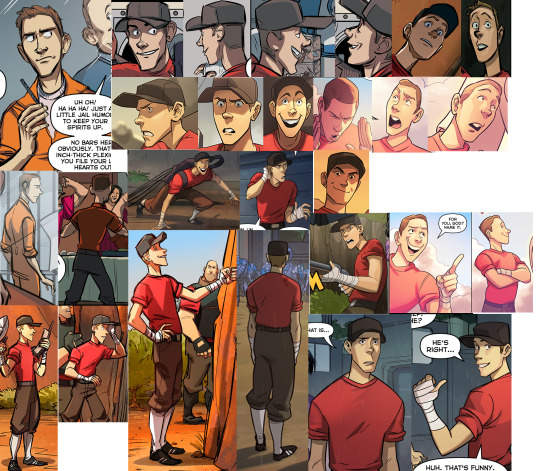
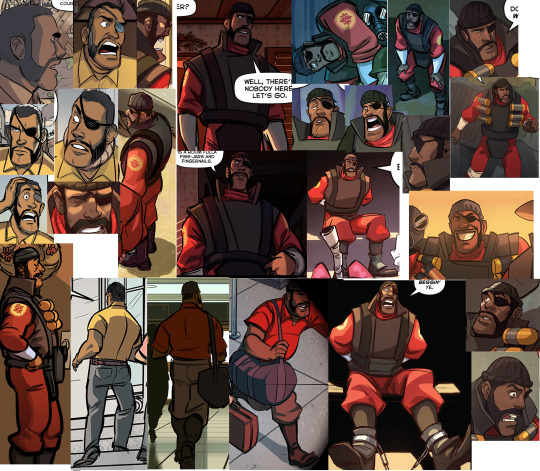


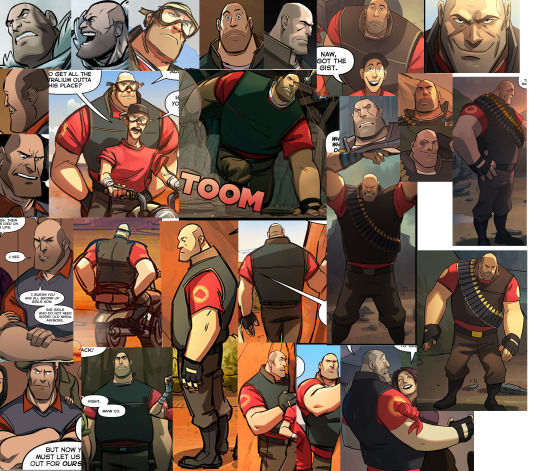


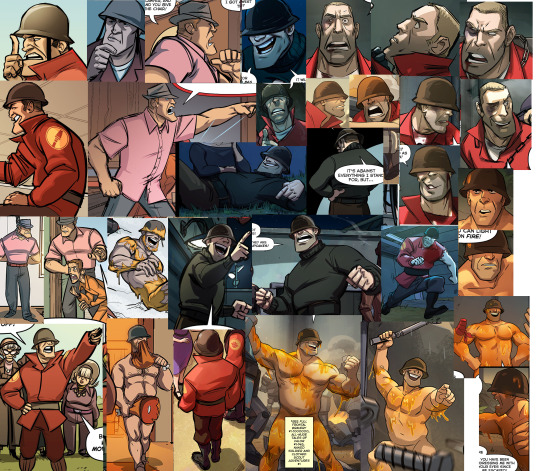

hey do you guys want some references. Because brother I have some fucking references for you.
#You have no IDEA how many times I clicked through the comics.#if I were a worse off person it might’ve driven me insane but luckily I have adhd so this has just been like a type of therapy to me#tf2#tf2 reference#Long post#Engie is the only one here with references pulled from multiple comics because of how little he pops up in the official series#And he is also the one whose canon art I purposefully ignore the most#he’s like 5’4” in my heart. Forever.#that blank head turn on the 3d model refs was just pulled from an article so. Let me know if I accidentally stole from someone or smth
6K notes
·
View notes
Text



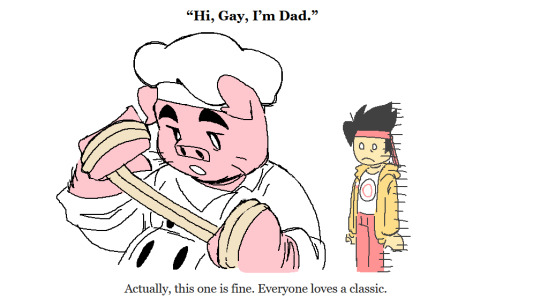

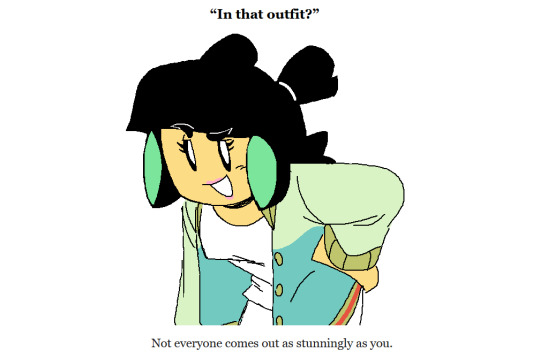

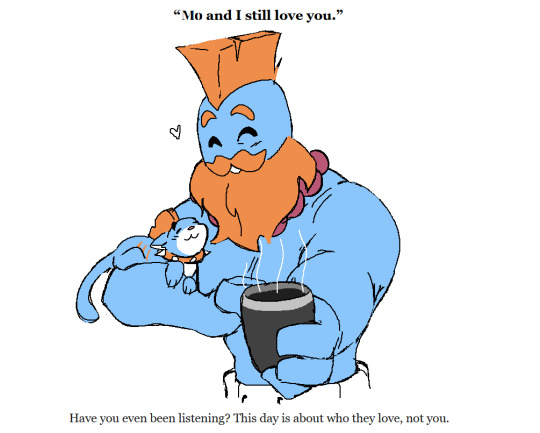

i cant even draw actual art anymore
#original is from a the onion article#lego monkie kid#monkie kid#lmk#lmk mk#qi xiaotian#lmk tang#six eared macaque#liu er mihou#lmk pigsy#hostess#lmk bai he#(i guess)#lmk mei#long xiaojiao#monkey king#sun wukong#lmk sandy#lmk red son#hong hai'er#first time i drew red son actually#shitpost#my art#ms paint#1k#2k#3k#4k#5k#6k
6K notes
·
View notes
Text
I was interested in purchasing a German pillow and this was the first result

So I checked it out, and

Hey, Ryan? Ryan.
Can you not fold it, my guy??
2K notes
·
View notes
Text
Wildflower meadows are beautiful; so beautiful in fact that a village in Britain has found they act as natural speed traps from motorists slowing down to look at them.
The village of Long Newnton in Gloucestershire has a problem with fast moving through-traffic between nearby towns. Almost all drivers moving through areas they frequent will break posted speed limits, and neither a 30 mile per hour limit, nor warning signs made any difference.
Officials first planted flowers along the roadside during the pandemic to help improve biodiversity.
But they noticed that as well as attracting more wildlife, motorists also slowed down when they passed the flowers.
#good news#good news network#wild flowers#meadow#speeding#Long Newnton#Gloucestershire#the article says that people might be slowing because they realise they're in an area that's being cared for#but I like to think they want to see the flowers better#'And then my heart with pleasure fills'#'and dances with the daffodils'#biodiversity#oh brave new world
22K notes
·
View notes
Text
“That’s it! I give up!” Phantom yelled. As though he had said something blasphemous, all fighting stopped as the participants stared in confusion. “You humans think you’re the paragon of all existence, proclaiming that anything different is lesser. Well we aren’t! We’re just as sentient as you are, and we have thoughts and feelings! You just choose to ignore it so you can justify your xenophobic actions!”
Phantom turned to Technus, who had frozen in shock as Phantom went on his tirade. “And you! Tell the other ghosts I’m done saving them, too, because none of you care! You don’t care if property is destroyed, or if humans get hurt, or if other ghosts get hurt! All you care about is your stupid Obsessions! You’re too caught up in your own mind to see what you’re doing to everyone around you!”
“But your Obsession is Protection, is it not? You’ve never stepped down from a fight-“ Technus began. Phantom didn’t let him finish.
“My Obsession is Space! If I had my way, I’d spend my nights stargazing, or maybe even on the moon! Instead I’m stuck cleaning up your messes because you can’t control yourselves!” Phantom growled. He glared at the crowd of people who had gathered, curious as to why all fighting had stopped.
“Humans are cruel and hateful. Ghosts are ignorant and careless. I’m tired of wasting my time protecting both sides from the other and being blamed for it. I quit. If anyone dies, or is captured, it’s no longer my problem.“
Like that, Phantom vanished.
The Fentons celebrated, not even noticing Technus make his own escape. The crowd murmured, worry just as prevalent as confidence. The few phones that were recording the event were put away, and later the footage would be checked. Unfortunately, most recordings were corrupted beyond recognition.
Most, but not all.
——————————————————
Amity Park. Ground Zero for the start of the war between the Living and the Dead. Humanity and Ghosts.
Why it had only recently escalated to this, Batman couldn’t tell. His research found that there had been a portal opened to the Realms years ago, and the laws passed just a year after that. Most of the town was stuck behind an information blackout that the government refused to give access to. Whatever happened, Constantine assured him that it was almost certainly the government’s fault.
After almost three weeks of trying to get beyond the firewalls, he finally figured it out. “Research” that claimed ghosts were nothing but evil. News articles calling “Phantom” a troublemaker. Forums that spoke about how “Phantom” ruined the town while fighting other ghosts.
A video, old and grainy but still clear enough to be used as evidence. A glowing, white-haired boy that told everyone he was done. That he was tired of fixing everything. Of saving everyone. That nobody was good, everyone was bad, and they were on their own.
They used to have a hero, but Phantom left. Without him, both sides tore at each other until there was nothing but an all-out assault. They needed to stop this, but without a mediator they would not make it through to the ghosts.
If they could find Phantom, perhaps they could fix everything before it was too late.
#Quasar AU#danny phantom#dc x dp#dp x dc#danny fenton#justice league#batman#basic summary: Danny gives up and leaves#after he leaves the ghosts grow bolder with nobody to stop them#and the hunters grow meaner#and after a lot of back and forth a ghost child is captured and killed#that makes the entire Realms rally for war#the JL are trying to figure out what made it this bad#the portal’s been open for a long time why now???#finally they see this one video#and all these news articles#and oh no#the one who was preventing the war was run off ages ago#they need to find him#and fast#part 1
4K notes
·
View notes
Text




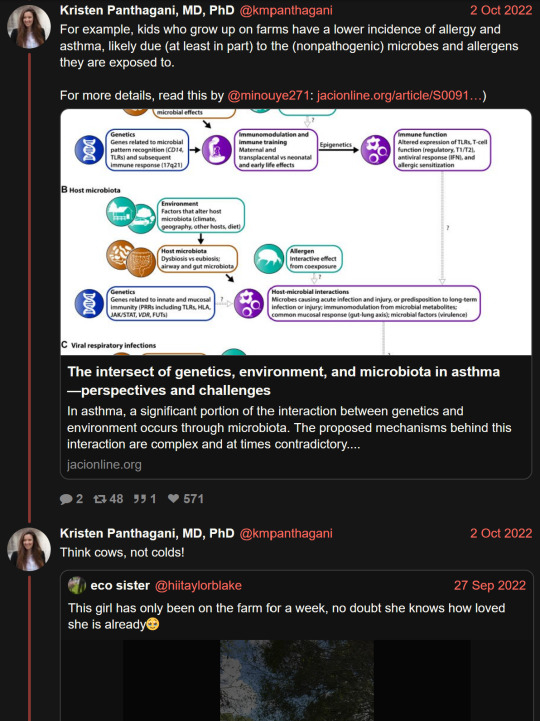


"Do not let anyone convince you that you need to get sick to be healthy."
#kristen panthagani#immunology#sars cov 2#long post#i s2g if i see one more bullshit article/comment about IMmUNiTY deBT........................#for the millionth billionth fucking time: IMMUNITY DEBT ISN'T REAL. there is NO SUCH THING as immunity debt caused by avoiding illness#and ANY dr/immunologist worth their salt in the year 2023 will tell you that#“but you have to train your immune system for it to get stronger!” nope doesn't work like that. the immune system is not a muscle#you might as well tell everyone that the reason they don't have skin like armoured steel is that they haven't been stabbed enough#tell all those drs treating tuberculosis patients that they're weakening their immunity by wearing respirators and NOT catching tb#let's all stop filtering the water while we're at it. have everyone get cholera - that'll fortify ppl's immune systems for sure#this world is a joke.#ppl buy into this shit and then wonder why the anti-vaxx/anti-science movement keeps growing
2K notes
·
View notes
Text
Begging the Hazbin fandom to go read some wiki articles on garden of Eden-era biblical lore. Not because the Hazbin fandom's doing a bad job or uncreative or anything so much as because apparently some of the preexisting lore is absolutely buckwild.
Like, I gave the wikipedia entry on Adam a poke, just 'cause curious, not at all expecting a "Lol yeah, he and Eve both lived for almost a thousand years after getting kicked out of Eden, and for the first hundred and thirty they just fucked off to separate sections of the world because they were mad at each other and both had a lot of sex with demons before getting back together, having Cain and Abel, and then presumably getting to question whether they shouldn't have just stuck with the demon sex when their firstborn killed their second-born."
It just feels like there's apparently a lot of stuff the Hazbin fandom could have a lot of fun with, you know?
#hazbin hotel#biblical lore#listen if I have to know this then so do you#also eden era biblical lore is kinda majorly depressing#meaning it's perfect for all you whump and angst lovers in this fandom#it's not phrased exactly how I phrased it in the wiki. mostly because this is a summary of a several sections of a VERY long article
662 notes
·
View notes
Text
Holy shit, the New York Times is FINALLY interviewing and listening to detransistioners.
The tide is turning.
Opinion by Pamela Paul
As Kids, They Thought They Were Trans. They No Longer Do.
Feb. 2, 2024

Grace Powell was 12 or 13 when she discovered she could be a boy.
Growing up in a relatively conservative community in Grand Rapids, Mich., Powell, like many teenagers, didn’t feel comfortable in her own skin. She was unpopular and frequently bullied. Puberty made everything worse. She suffered from depression and was in and out of therapy.
“I felt so detached from my body, and the way it was developing felt hostile to me,” Powell told me. It was classic gender dysphoria, a feeling of discomfort with your sex.
Reading about transgender people online, Powell believed that the reason she didn’t feel comfortable in her body was that she was in the wrong body. Transitioning seemed like the obvious solution. The narrative she had heard and absorbed was that if you don’t transition, you’ll kill yourself.
At 17, desperate to begin hormone therapy, Powell broke the news to her parents. They sent her to a gender specialist to make sure she was serious. In the fall of her senior year of high school, she started cross-sex hormones. She had a double mastectomy the summer before college, then went off as a transgender man named Grayson to Sarah Lawrence College, where she was paired with a male roommate on a men’s floor. At 5-foot-3, she felt she came across as a very effeminate gay man.
At no point during her medical or surgical transition, Powell says, did anyone ask her about the reasons behind her gender dysphoria or her depression. At no point was she asked about her sexual orientation. And at no point was she asked about any previous trauma, and so neither the therapists nor the doctors ever learned that she’d been sexually abused as a child.
“I wish there had been more open conversations,” Powell, now 23 and detransitioned, told me. “But I was told there is one cure and one thing to do if this is your problem, and this will help you.”
Progressives often portray the heated debate over childhood transgender care as a clash between those who are trying to help growing numbers of children express what they believe their genders to be and conservative politicians who won’t let kids be themselves.
But right-wing demagogues are not the only ones who have inflamed this debate. Transgender activists have pushed their own ideological extremism, especially by pressing for a treatment orthodoxy that has faced increased scrutiny in recent years. Under that model of care, clinicians are expected to affirm a young person’s assertion of gender identity and even provide medical treatment before, or even without, exploring other possible sources of distress.
Many who think there needs to be a more cautious approach — including well-meaning liberal parents, doctors and people who have undergone gender transition and subsequently regretted their procedures — have been attacked as anti-trans and intimidated into silencing their concerns.
And while Donald Trump denounces “left-wing gender insanity” and many trans activists describe any opposition as transphobic, parents in America’s vast ideological middle can find little dispassionate discussion of the genuine risks or trade-offs involved in what proponents call gender-affirming care.
Powell’s story shows how easy it is for young people to get caught up by the pull of ideology in this atmosphere.
“What should be a medical and psychological issue has been morphed into a political one,” Powell lamented during our conversation. “It’s a mess.”
A New and Growing Group of Patients
Many transgender adults are happy with their transitions and, whether they began to transition as adults or adolescents, feel it was life changing, even lifesaving. The small but rapidly growing number of children who express gender dysphoria and who transition at an early age, according to clinicians, is a recent and more controversial phenomenon.
Laura Edwards-Leeper, the founding psychologist of the first pediatric gender clinic in the United States, said that when she started her practice in 2007, most of her patients had longstanding and deep-seated gender dysphoria. Transitioning clearly made sense for almost all of them, and any mental health issues they had were generally resolved through gender transition.
“But that is just not the case anymore,” she told me recently. While she doesn’t regret transitioning the earlier cohort of patients and opposes government bans on transgender medical care, she said, “As far as I can tell, there are no professional organizations who are stepping in to regulate what’s going on.”

Most of her patients now, she said, have no history of childhood gender dysphoria. Others refer to this phenomenon, with some controversy, as rapid onset gender dysphoria, in which adolescents, particularly tween and teenage girls, express gender dysphoria despite never having done so when they were younger. Frequently, they have mental health issues unrelated to gender. While professional associations say there is a lack of quality research on rapid onset gender dysphoria, several researchers have documented the phenomenon, and many health care providers have seen evidence of it in their practices.
“The population has changed drastically,” said Edwards-Leeper, a former head of the Child and Adolescent Committee for the World Professional Association for Transgender Health, the organization responsible for setting gender transition guidelines for medical professionals.
For these young people, she told me, “you have to take time to really assess what’s going on and hear the timeline and get the parents’ perspective in order to create an individualized treatment plan. Many providers are completely missing that step.”
Yet those health care professionals and scientists who do not think clinicians should automatically agree to a young person’s self-diagnosis are often afraid to speak out. A report commissioned by the National Health Service about Britain’s Tavistock gender clinic, which, until it was ordered to be shut down, was the country’s only health center dedicated to gender identity, noted that “primary and secondary care staff have told us that they feel under pressure to adopt an unquestioning affirmative approach and that this is at odds with the standard process of clinical assessment and diagnosis that they have been trained to undertake in all other clinical encounters.”
Of the dozens of students she’s trained as psychologists, Edwards-Leeper said, few still seem to be providing gender-related care. While her students have left the field for various reasons, “some have told me that they didn’t feel they could continue because of the pushback, the accusations of being transphobic, from being pro-assessment and wanting a more thorough process,” she said.
They have good reasons to be wary. Stephanie Winn, a licensed marriage and family therapist in Oregon, was trained in gender-affirming care and treated multiple transgender patients. But in 2020, after coming across detransition videos online, she began to doubt the gender-affirming model. In 2021 she spoke out in favor of approaching gender dysphoria in a more considered way, urging others in the field to pay attention to detransitioners, people who no longer consider themselves transgender after undergoing medical or surgical interventions. She has since been attacked by transgender activists. Some threatened to send complaints to her licensing board saying that she was trying to make trans kids change their minds through conversion therapy.
In April 2022, the Oregon Board of Licensed Professional Counselors and Therapists told Winn that she was under investigation. Her case was ultimately dismissed, but Winn no longer treats minors and practices only online, where many of her patients are worried parents of trans-identifying children.
“I don’t feel safe having a location where people can find me,” she said.
Detransitioners say that only conservative media outlets seem interested in telling their stories, which has left them open to attacks as hapless tools of the right, something that frustrated and dismayed every detransitioner I interviewed. These are people who were once the trans-identified kids that so many organizations say they’re trying to protect — but when they change their minds, they say, they feel abandoned.
Most parents and clinicians are simply trying to do what they think is best for the children involved. But parents with qualms about the current model of care are frustrated by what they see as a lack of options.
Parents told me it was a struggle to balance the desire to compassionately support a child with gender dysphoria while seeking the best psychological and medical care. Many believed their kids were gay or dealing with an array of complicated issues. But all said they felt compelled by gender clinicians, doctors, schools and social pressure to accede to their child’s declared gender identity even if they had serious doubts. They feared it would tear apart their family if they didn’t unquestioningly support social transition and medical treatment. All asked to speak anonymously, so desperate were they to maintain or repair any relationship with their children, some of whom were currently estranged.
Several of those who questioned their child’s self-diagnosis told me it had ruined their relationship. A few parents said simply, “I feel like I’ve lost my daughter.”
One mother described a meeting with 12 other parents in a support group for relatives of trans-identified youth where all of the participants described their children as autistic or otherwise neurodivergent. To all questions, the woman running the meeting replied, “Just let them transition.” The mother left in shock. How would hormones help a child with obsessive-compulsive disorder or depression? she wondered.
Some parents have found refuge in anonymous online support groups. There, people share tips on finding caregivers who will explore the causes of their children’s distress or tend to their overall emotional and developmental health and well-being without automatically acceding to their children’s self-diagnosis.
Many parents of kids who consider themselves trans say their children were introduced to transgender influencers on YouTube or TikTok, a phenomenon intensified for some by the isolation and online cocoon of Covid. Others say their kids learned these ideas in the classroom, as early as elementary school, often in child-friendly ways through curriculums supplied by trans rights organizations, with concepts like the gender unicorn or the Genderbread person.
‘Do You Want a Dead Son or a Live Daughter?’
After Kathleen’s 15-year-old son, whom she described as an obsessive child, abruptly told his parents he was trans, the doctor who was going to assess whether he had A.D.H.D. referred him instead to someone who specialized in both A.D.H.D. and gender. Kathleen, who asked to be identified only by her first name to protect her son’s privacy, assumed that the specialist would do some kind of evaluation or assessment. That was not the case.
The meeting was brief and began on a shocking note. “In front of my son, the therapist said, ‘Do you want a dead son or a live daughter?’” Kathleen recounted.
Parents are routinely warned that to pursue any path outside of agreeing with a child’s self-declared gender identity is to put a gender dysphoric youth at risk for suicide, which feels to many people like emotional blackmail. Proponents of the gender-affirming model have cited studies showing an association between that standard of care and a lower risk of suicide. But those studies were found to have methodological flaws or have been deemed not entirely conclusive. A survey of studies on the psychological effects of cross-sex hormones, published three years ago in The Journal of the Endocrine Society, the professional organization for hormone specialists, found it “could not draw any conclusions about death by suicide.” In a letter to The Wall Street Journal last year, 21 experts from nine countries said that survey was one reason they believed there was “no reliable evidence to suggest that hormonal transition is an effective suicide prevention measure.”
Moreover, the incidence of suicidal thoughts and attempts among gender dysphoric youth is complicated by the high incidence of accompanying conditions, such as autism spectrum disorder. As one systematic overview put it, “Children with gender dysphoria often experience a range of psychiatric comorbidities, with a high prevalence of mood and anxiety disorders, trauma, eating disorders and autism spectrum conditions, suicidality and self-harm.”
But rather than being treated as patients who deserve unbiased professional help, children with gender dysphoria often become political pawns.
Conservative lawmakers are working to ban access to gender care for minors and occasionally for adults as well. On the other side, however, many medical and mental health practitioners feel their hands have been tied by activist pressure and organizational capture. They say that it has become difficult to practice responsible mental health care or medicine for these young people.
Pediatricians, psychologists and other clinicians who dissent from this orthodoxy, believing that it is not based on reliable evidence, feel frustrated by their professional organizations. The American Psychological Association, American Psychiatric Association and the American Academy of Pediatrics have wholeheartedly backed the gender-affirming model.
In 2021, Aaron Kimberly, a 50-year-old trans man and registered nurse, left the clinic in British Columbia where his job focused on the intake and assessment of gender-dysphoric youth. Kimberly received a comprehensive screening when he embarked on his own successful transition at age 33, which resolved the gender dysphoria he experienced from an early age.
But when the gender-affirming model was introduced at his clinic, he was instructed to support the initiation of hormone treatment for incoming patients regardless of whether they had complex mental problems, experiences with trauma or were otherwise “severely unwell,” Kimberly said. When he referred patients for further mental health care rather than immediate hormone treatment, he said he was accused of what they called gatekeeping and had to change jobs.
“I realized something had gone totally off the rails,” Kimberly, who subsequently founded the Gender Dysphoria Alliance and the L.G.B.T. Courage Coalition to advocate better gender care, told me.
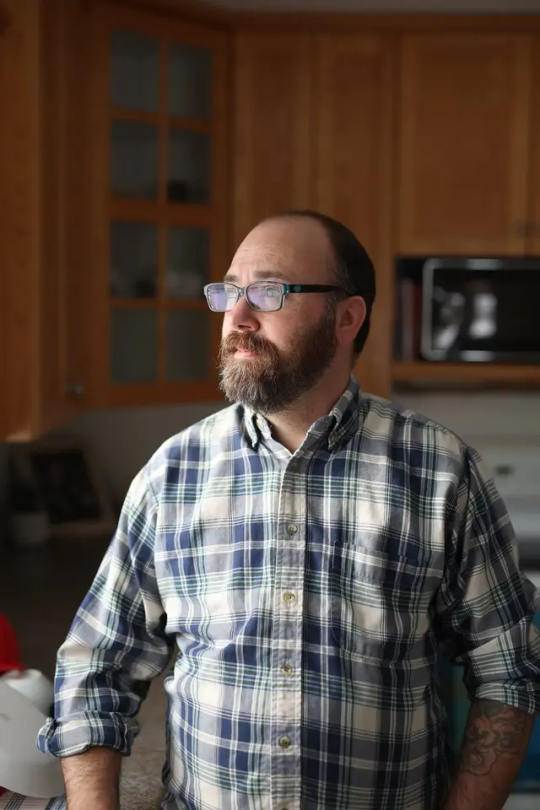
Gay men and women often told me they fear that same-sex-attracted kids, especially effeminate boys and tomboy girls who are gender nonconforming, will be transitioned during a normal phase of childhood and before sexual maturation — and that gender ideology can mask and even abet homophobia.
As one detransitioned man, now in a gay relationship, put it, “I was a gay man pumped up to look like a woman and dated a lesbian who was pumped up to look like a man. If that’s not conversion therapy, I don’t know what is.”
“I transitioned because I didn’t want to be gay,” Kasey Emerick, a 23-year-old woman and detransitioner from Pennsylvania, told me. Raised in a conservative Christian church, she said, “I believed homosexuality was a sin.”
When she was 15, Emerick confessed her homosexuality to her mother. Her mother attributed her sexual orientation to trauma — Emerick’s father was convicted of raping and assaulting her repeatedly when she was between the ages of 4 and 7 — but after catching Emerick texting with another girl at age 16, she took away her phone. When Emerick melted down, her mother admitted her to a psychiatric hospital. While there, Emerick told herself, “If I was a boy, none of this would have happened.”
In May 2017, Emerick began searching “gender” online and encountered trans advocacy websites. After realizing she could “pick the other side,” she told her mother, “I’m sick of being called a dyke and not a real girl.” If she were a man, she’d be free to pursue relationships with women.
That September, she and her mother met with a licensed professional counselor for the first of two 90-minute consultations. She told the counselor that she had wished to be a Boy Scout rather than a Girl Scout. She said she didn’t like being gay or a butch lesbian. She also told the counselor that she had suffered from anxiety, depression and suicidal ideation. The clinic recommended testosterone, which was prescribed by a nearby L.G.B.T.Q. health clinic. Shortly thereafter, she was also diagnosed with A.D.H.D. She developed panic attacks. At age 17, she was cleared for a double mastectomy.
“I’m thinking, ‘Oh my God, I’m having my breasts removed. I’m 17. I’m too young for this,’” she recalled. But she went ahead with the operation.
“Transition felt like a way to control something when I couldn’t control anything in my life,” Emerick explained. But after living as a trans man for five years, Emerick realized her mental health symptoms were only getting worse. In the fall of 2022, she came out as a detransitioner on Twitter and was immediately attacked. Transgender influencers told her she was bald and ugly. She received multiple threats.
“I thought my life was over,” she said. “I realized that I had lived a lie for over five years.”

Today Emerick’s voice, permanently altered by testosterone, is that of a man. When she tells people she’s a detransitioner, they ask when she plans to stop taking T and live as a woman. “I’ve been off it for a year,” she replies.
Once, after she recounted her story to a therapist, the therapist tried to reassure her. If it’s any consolation, the therapist remarked, “I would never have guessed that you were once a trans woman.” Emerick replied, “Wait, what sex do you think I am?”
To the trans activist dictum that children know their gender best, it is important to add something all parents know from experience: Children change their minds all the time. One mother told me that after her teenage son desisted — pulled back from a trans identity before any irreversible medical procedures — he explained, “I was just rebelling. I look at it like a subculture, like being goth.”
“The job of children and adolescents is to experiment and explore where they fit into the world, and a big part of that exploration, especially during adolescence, is around their sense of identity,” Sasha Ayad, a licensed professional counselor based in Phoenix, told me. “Children at that age often present with a great deal of certainty and urgency about who they believe they are at the time and things they would like to do in order to enact that sense of identity.”
Ayad, a co-author of “When Kids Say They’re Trans: A Guide for Thoughtful Parents,” advises parents to be wary of the gender affirmation model. “We’ve always known that adolescents are particularly malleable in relationship to their peers and their social context and that exploration is often an attempt to navigate difficulties of that stage, such as puberty, coming to terms with the responsibilities and complications of young adulthood, romance and solidifying their sexual orientation,” she told me. For providing this kind of exploratory approach in her own practice with gender dysphoric youth, Ayad has had her license challenged twice, both times by adults who were not her patients. Both times, the charges were dismissed.
Studies show that around eight in 10 cases of childhood gender dysphoria resolve themselves by puberty and 30 percent of people on hormone therapy discontinue its use within four years, though the effects, including infertility, are often irreversible.
Proponents of early social transition and medical interventions for gender dysphoric youth cite a 2022 study showing that 98 percent of children who took both puberty blockers and cross-sex hormones continued treatment for short periods, and another study that tracked 317 children who socially transitioned between the ages of 3 and 12, which found that 94 percent of them still identified as transgender five years later. But such early interventions may cement children’s self-conceptions without giving them time to think or sexually mature.
‘The Process of Transition Didn’t Make Me Feel Better’
At the end of her freshman year of college, Grace Powell, horrifically depressed, began dissociating, feeling detached from her body and from reality, which had never happened to her before. Ultimately, she said, “the process of transition didn’t make me feel better. It magnified what I found was wrong with myself.”
“I expected it to change everything, but I was just me, with a slightly deeper voice,” she added. “It took me two years to start detransitioning and living as Grace again.”
She tried in vain to find a therapist who would treat her underlying issues, but they kept asking her: How do you want to be seen? Do you want to be nonbinary? Powell wanted to talk about her trauma, not her identity or her gender presentation. She ended up getting online therapy from a former employee of the Tavistock clinic in Britain. This therapist, a woman who has broken from the gender-affirming model, talked Grace through what she sees as her failure to launch and her efforts to reset. The therapist asked questions like: Who is Grace? What do you want from your life? For the first time, Powell felt someone was seeing and helping her as a person, not simply looking to slot her into an identity category.
Many detransitioners say they face ostracism and silencing because of the toxic politics around transgender issues.
“It is extraordinarily frustrating to feel that something I am is inherently political,” Powell told me. “I’ve been accused multiple times that I’m some right-winger who’s making a fake narrative to discredit transgender people, which is just crazy.”
While she believes there are people who benefit from transitioning, “I wish more people would understand that there’s not a one-size-fits-all solution,” she said. “I wish we could have that conversation.”
In a recent study in The Archives of Sexual Behavior, about 40 young detransitioners out of 78 surveyed said they had suffered from rapid onset gender dysphoria. Trans activists have fought hard to suppress any discussion of rapid onset gender dysphoria, despite evidence that the condition is real. In its guide for journalists, the activist organization GLAAD warns the media against using the term, as it is not “a formal condition or diagnosis.” Human Rights Campaign, another activist group, calls it “a right-wing theory.” A group of professional organizations put out a statement urging clinicians to eliminate the term from use.
Nobody knows how many young people desist after social, medical or surgical transitions. Trans activists often cite low regret rates for gender transition, along with low figures for detransition. But those studies, which often rely on self-reported cases to gender clinics, likely understate the actual numbers. None of the seven detransitioners I interviewed, for instance, even considered reporting back to the gender clinics that prescribed them medication they now consider to have been a mistake. Nor did they know any other detransitioners who had done so.
As Americans furiously debate the basis of transgender care, a number of advances in understanding have taken place in Europe, where the early Dutch studies that became the underpinning of gender-affirming care have been broadly questioned and criticized. Unlike some of the current population of gender dysphoric youth, the Dutch study participants had no serious psychological conditions. Those studies were riddled with methodological flaws and weaknesses. There was no evidence that any intervention was lifesaving. There was no long-term follow-up with any of the study’s 55 participants or the 15 who dropped out. A British effort to replicate the study said that it “identified no changes in psychological function” and that more studies were needed.
In countries like Sweden, Norway, France, the Netherlands and Britain — long considered exemplars of gender progress — medical professionals have recognized that early research on medical interventions for childhood gender dysphoria was either faulty or incomplete. Last month, the World Health Organization, in explaining why it is developing “a guideline on the health of trans and gender diverse people,” said it will cover only adults because “the evidence base for children and adolescents is limited and variable regarding the longer-term outcomes of gender-affirming care for children and adolescents.”
But in America, and Canada, the results of those widely criticized Dutch studies are falsely presented to the public as settled science.
Other countries have recently halted or limited the medical and surgical treatment of gender dysphoric youth, pending further study. Britain’s Tavistock clinic was ordered to be shut down next month, after a National Health Service-commissioned investigation found deficiencies in service and “a lack of consensus and open discussion about the nature of gender dysphoria and therefore about the appropriate clinical response.”
Meanwhile, the American medical establishment has hunkered down, stuck in an outdated model of gender affirmation. The American Academy of Pediatrics only recently agreed to conduct more research in response to yearslong efforts by dissenting experts, including Dr. Julia Mason, a self-described “bleeding-heart liberal.”
The larger threat to transgender people comes from Republicans who wish to deny them rights and protections. But the doctrinal rigidity of the progressive wing of the Democratic Party is disappointing, frustrating and counterproductive.
“I was always a liberal Democrat,” one woman whose son desisted after social transition and hormone therapy told me. “Now I feel politically homeless.”
She noted that the Biden administration has “unequivocally” supported gender-affirming care for minors, in cases in which it deems it “medically appropriate and necessary.” Rachel Levine, the assistant secretary for health at the U.S. Department of Health and Human Services, told NPR in 2022 that “there is no argument among medical professionals — pediatricians, pediatric endocrinologists, adolescent medicine physicians, adolescent psychiatrists, psychologists, et cetera — about the value and the importance of gender-affirming care.”
Of course, politics should not influence medical practice, whether the issue is birth control, abortion or gender medicine. But unfortunately, politics has gotten in the way of progress. Last year The Economist published a thorough investigation into America’s approach to gender medicine. Zanny Minton Beddoes, the editor, put the issue into political context. “If you look internationally at countries in Europe, the U.K. included, their medical establishments are much more concerned,” Beddoes told Vanity Fair. “But here — in part because this has become wrapped up in the culture wars where you have, you know, crazy extremes from the Republican right — if you want to be an upstanding liberal, you feel like you can’t say anything.”
Some people are trying to open up that dialogue, or at least provide outlets for kids and families to seek a more therapeutic approach to gender dysphoria.
Paul Garcia-Ryan is a psychotherapist in New York who cares for kids and families seeking holistic, exploratory care for gender dysphoria. He is also a detransitioner who from ages 15 to 30 fully believed he was a woman.
Garcia-Ryan is gay, but as a boy, he said, “it was much less threatening to my psyche to think that I was a straight girl born into the wrong body — that I had a medical condition that could be tended to.” When he visited a clinic at 15, the clinician immediately affirmed he was female, and rather than explore the reasons for his mental distress, simply confirmed Garcia-Ryan’s belief that he was not meant to be a man.
Once in college, he began medically transitioning and eventually had surgery on his genitals. Severe medical complications from both the surgery and hormone medication led him to reconsider what he had done, and to detransition. He also reconsidered the basis of gender affirmation, which, as a licensed clinical social worker at a gender clinic, he had been trained in and provided to clients.
“You’re made to believe these slogans,” he said. “Evidence-based, lifesaving care, safe and effective, medically necessary, the science is settled — and none of that is evidence based.”
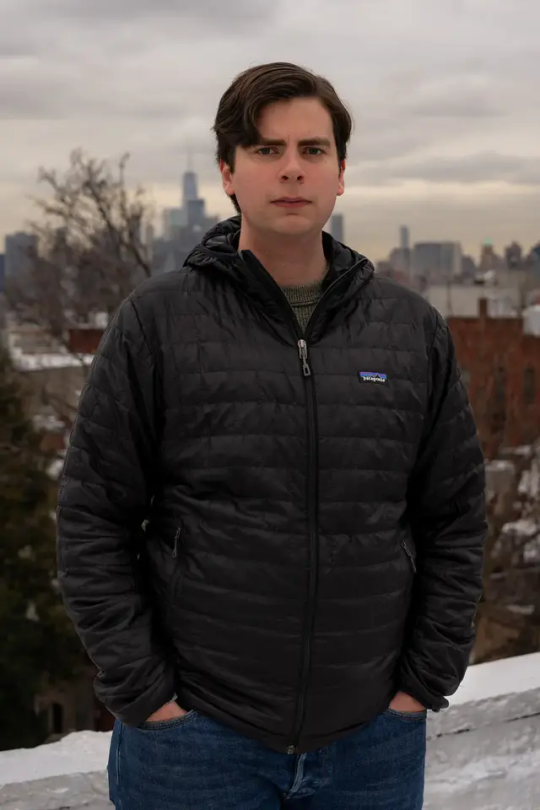
Garcia-Ryan, 32, is now the board president of Therapy First, an organization that supports therapists who do not agree with the gender affirmation model. He thinks transition can help some people manage the symptoms of gender dysphoria but no longer believes anyone under 25 should socially, medically or surgically transition without exploratory psychotherapy first.
“When a professional affirms a gender identity for a younger person, what they are doing is implementing a psychological intervention that narrows a person’s sense of self and closes off their options for considering what’s possible for them,” Garcia-Ryan told me.
Instead of promoting unproven treatments for children, which surveys show many Americans are uncomfortable with, transgender activists would be more effective if they focused on a shared agenda. Most Americans across the political spectrum can agree on the need for legal protections for transgender adults. They would also probably support additional research on the needs of young people reporting gender dysphoria so that kids could get the best treatment possible.
A shift in this direction would model tolerance and acceptance. It would prioritize compassion over demonization. It would require rising above culture-war politics and returning to reason. It would be the most humane path forward. And it would be the right thing to do.
*~*~*~*~*~*
For those who want tor ead more by those fighting the cancellation forquestioning, read:
Graham Lineham, who's been fighting since the beginning and paid the price, but is not seeing things turn around.
The Glinner Update, Grahan Linehan's Substack.
Kellie-Jay Keen @ThePosieParker, who's been physically attacked for organizing events for women demanding women-only spaces.
REDUXX, Feminst news & opinion.
Gays Against Groomers @againstgrmrs, A nonprofit of gay people and others within the community against the sexualization, indoctrination and medicalization of children under the guise of "LGBTQIA+"
#detransitioners#detransition#gender critical#New York Times#gays#lesbians#trans#trans insanity#long post#article#detrans#transgender#post trans#desisted
704 notes
·
View notes
Text
I've seen a couple of takes about Disco Elysium being copaganda going around recently, and beyond the fact that DE is relentlessly critical of the police force in general and makes explicit reference to the failures of the system that allow the officers in game to abuse their power, I also think it's important to note that there very literally is an in-world version of copaganda that the writers of the game use to parody that romanticised view of the brutality of policing. The RCM at their inception were structurally inspired by in-world copaganda- their culture, their "fashions, even weapon preferences, borrow heavily from classic Vespertine cop shows." Every investigation is it's own little drama, every officer imagining themselves to be the bad-ass hero of their own crime serial. Detectives name their cases like they're naming episodes of a TV series in a "robust but literary system"; a title that "draws inspiration from snoop fiction and Vespertine cop show staples". They give themselves nicknames to sound like cool, suave fictional officers- Ace, Dick Mullen, etc.- from the cool, suave world of copaganda.
The legend of the RCM's inception, the "point of contention" over its uncertain origins, is even an extention of that; the whole organisation is shrouded in this self-fictionalising mythos that allows for distance that in turn obfuscates much of its violence to the officers that participate in it. They get to convince themselves that they're not abusing their power; they're the hero of the story! The dichotomy of "good guy" taking out the "baddies," a manifestation of the libertarian fantasy of the "good guy with a gun" who does what it takes, just like in Annette's detective novels, and at the same time who rails against oversight bodies like Internal Affairs/'the rat squad' because due process slows down the immediate satisfaction of Swift Justice, despite Internal Affairs existing to protect the citizens from overreach on behalf of the police. "Wanton brutality" from police in their real world is a cold bitter reality but Dick Mullen was "made to crack skulls," "bend the rules and solve cases no one else can," and which version of that story is more comforting to the overworked, underfunded officers of the RCM?





The level of fantasy and detachment required for the cops to still see themselves as the good guys after everything that they do in the line of duty mimics The Pigs and her breakdown too; she parallels Harry so clearly. Both "did right by the kids" in the past, hoping for a better future- Marianne (The Pigs) by looking out for Titus and the Hardy boys when they were young, Harry in his role as a gym teacher. Both abandoned and left behind by the system that the RCM uphold- a brutal capitalist landscape with no safety nets. Both turning the source of their trauma into a costume, a performance, a shield, shaped by "radio waves and cop shows." The Pigs uses RCM items scavenged from the Esperance where they'd been thrown away, while Harry uses the Dick Mullen hat that Annette gives him but both are essentially in costume.
Harry identifies himself with the fictional detective as a kind of wish fulfilment; Dick Mullen is "wicked smart." He doesn't fuck up his cases and when he's sad it's not pathetic; it's effortlessly cool brooding and everyone sympathises. Everyone loves him. His violence- "skull crack[ing]"- is justified because he's a "good guy" enacting that violence against the victims of police brutality sorry "bad guys". He doesn't ever face repercussions; "Dick Mullen won't be sent to the clink for the sake of some legal niceties!" So if Harry is Dick Mullen then his failures, his breakdown, they're all just a part of being a "bad-ass, on-the-edge disco cop." He's not wrong, he's a hero! This idealised fictionalised idea of the police force, this "new, sadly better, reality" that both Harry and The Pigs cling to is "escapist stuff," "receed[ing] into a ludicrous fantasy world," so far removed from the brutal material reality that they're in.


My point is, idk. Disco Elysium is so far from being copaganda. It is a multi-million word long dissection of it, of the purpose of policing, of state sanctioned violence and its interaction with capital and the fallout experienced within the wider community as well as the trauma cycle created for individual officers. A dissection of how copaganda interacts with RCM culture and perception, and by extension how we interact with irl perceptions of police through that lens.
#ouaghhhhhhh disclaimer; i am bad with words and im not sure that i've properly expressed what i'm trying to say but this is getting so long#the cops are not meant to be the good guys#if you think i've missed something here pls let me know!!#disco elysium#harry du bois#DE rambling#marianne leplante#the pigs#actually just one last note- this isnt in response to any one particular thing ive seen but a few different posts comments and articles
2K notes
·
View notes
Text





Screenshots of McCoy smiling (and a few where he isn't) from every Star Trek episode in production order.
#happy birthday de!!!#this was finished weeks ago but i decided i should upload it today :)#leonard mccoy#star trek#star trek tos#deforest kelley#my posts#my screenshots#smiley mccoy#the idea was one smile from each episode#there was an article once that mentioned mccoy seemingly being 'unable to smile'#so whenever he does#which is very often#i always quote that#i feel like i could have chosen 'better' smiles for a lot of these but it just proves my point that he smiles a lot :)#long post#ish
415 notes
·
View notes
Text
There is a reason why Ranpo often struggles with getting lost/finding his way back home
This might seem like a far fetched beginning, but for this to be clear I do need to explain one pretty easy to understand (I prommy) math concept - a random walk. In math, a random walk describes a path consisting of random steps in some sort of mathematical space. A path of a molecule in a gas is a random walk, and individual foraging animal's movement is a random walk, and even your Tw*tter follow suggestions use a random walk process. I have heard of it from Markov's chains and computer science. You might not have heard of it at all which is both valid and understandable. The important parts are:
1) a random walk is. well. a random walk;
2) In Japanese, while most commonly referred to by its transliterated name, ランダムウォーク (literally 'random walk' in katakana), a random walk can also be called 乱歩, with 乱 meaning 'disordered' and 歩 meaning 'path.
If you (unlike me) know Japanese, you already see where I am going with this - yes, 乱歩 reads as 'Ranpo'. It is, in fact, the same 'Ranpo' as in our beloved detectives name, Edogawa Ranpo!

So Ranpo's general directionally challenges nature could be a nod towards his name, meaning that he probably gets lost easily and struggles with routes due to taking random detours and turns (just like a random walk ^-^)

#bsd#bungou stray dogs#ranpo edogawa#dont think its long enough as to require putting the entire thing under readmore? do tell me tho.#also. there are benefits on reading wikipedia articles on math concepts for fun apparently. bc thats how i figured that one out#lis smart
641 notes
·
View notes
Text

Partly for the prolific volume of projects artists release each year and partly for the fluid definition of an album (running anywhere from three to 13 tracks), an annual ranking of K-pop albums is never easy. As South Korea continues to extend its global musical influence, certain projects transcend hit-song compilations, presenting larger visions and conceptual narratives.
In 2023, stars like V, WOODZ and ONEW used their latest solo projects to share the music that inspires them at their core as artists and let listeners settle into sonic worlds they’ve developed.
[...]
First Place: Onew, Circle The First Album

While it’s somewhat criminal to think that 15 years after ONEW’s debut with SHINee in 2008 we only just received his first full Korean album, the singer-songwriter himself would say that now was the perfect time for Circle. A musical journey unlike anything released this year, ONEW shared that he had attempted to record the album’s title track before dropping his Dice EP in early 2022, but felt it wasn’t at the level of perfection it deserved and held onto the song. ONEW then involved himself in every aspect of Circle‘s production process, from meticulous mixing and mastering to tuning, beats, recording and mastering, attesting to the singer-songwriter’s dedication to artistic expression.
The single “O (Circle)” opens the album with an intriguing blend of electronica and strings, while its gospel-tinged chorus emphasizes lyrics about the circular nature of life and how memories, feelings and dreams are all fleeting. The 10 tracks on Circle develop unique transformations from start to finish: the breezy melodies in “Cough” are paired with loneliness-themed lyrics and a melancholy instrumental breakdown, while “Rain on Me” starts with aggressive acoustic guitar strumming before transitioning into an atmospheric, percussive ballad. Sweet surprises abound, too: ONEW scats on the jazz-rap hybrid “Caramel” and gives a glimpse into his indie-rock side on “Parachute.”
The album’s effortless flow is anchored by ONEW’s famously solid yet understated vocals. As Circle concludes with the tender piano ballad “Always” which addresses themes of loyalty and resilience, the listener wonders if it’s an allegory for ONEW’s public journey through health challenges, including vocal cord surgery. Even without any writing credits on Circle, ONEW’s presence is undeniably felt in this seamless collection that boasts an emotional depth brought on by 15 years in the game. That’s the kind of introspection you can’t rush or doctor through A&R but need to cycle through and arrive at when the moment is right. From scheduling this album’s release to the messages on the final track, time is definitely on ONEW’s side to deliver such a project. — J.B.
source
#231230#shinee#onew#lee jinki#jinki#hard era#circle album praise#articles#eng#circle album review#billboard#long post#jeff benjamin#jessica oak#circle achievements
388 notes
·
View notes